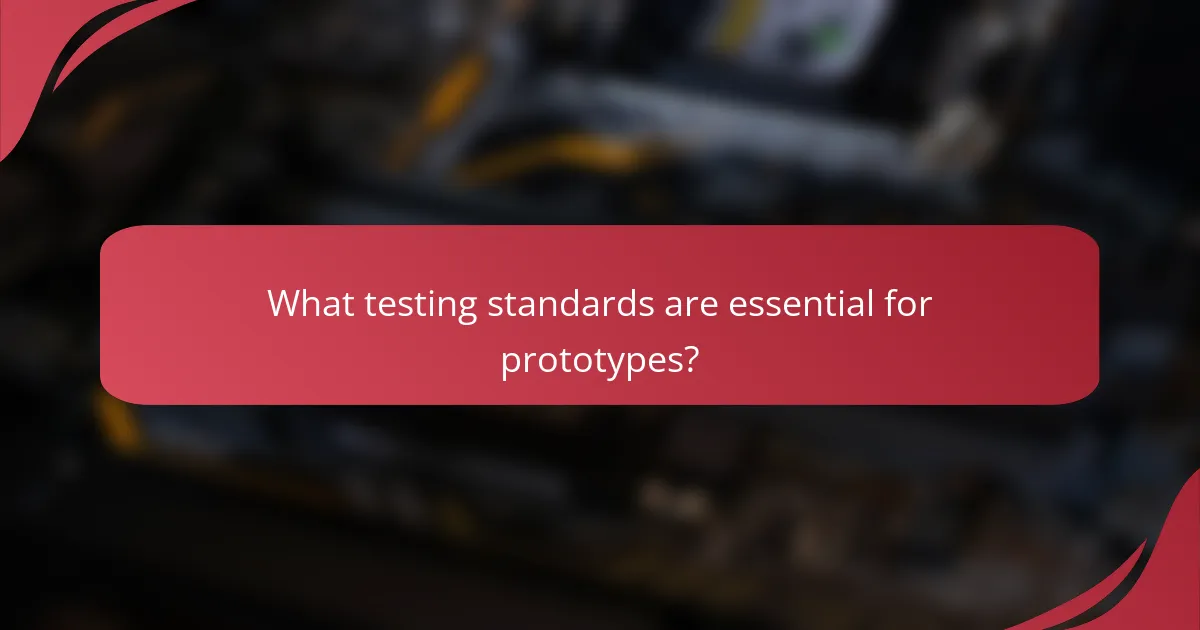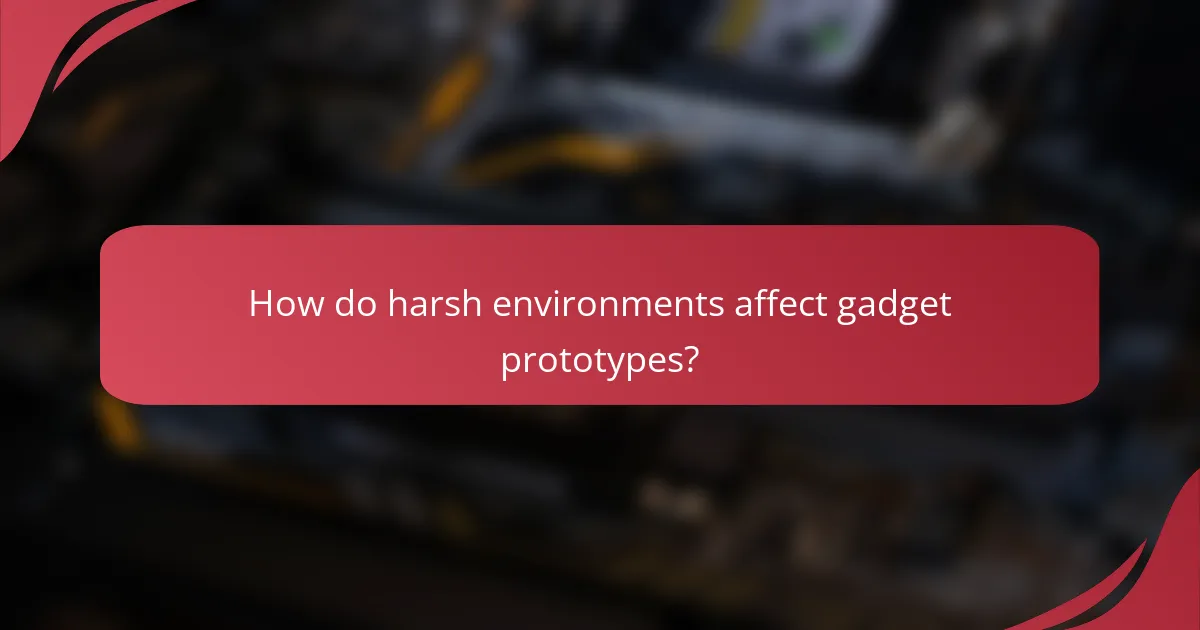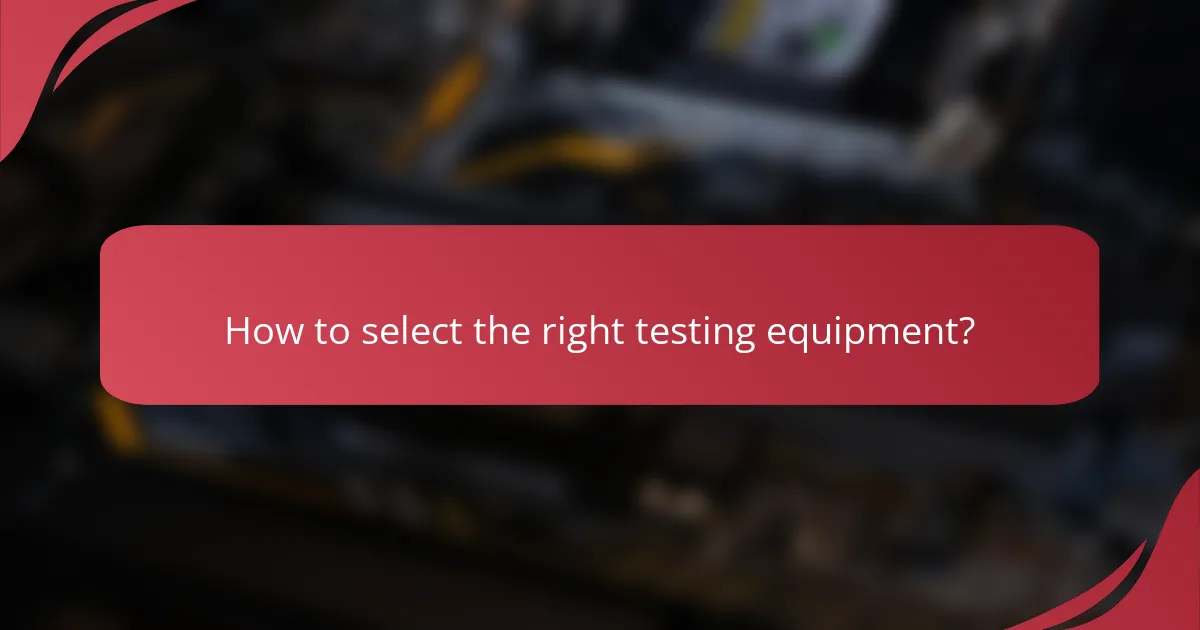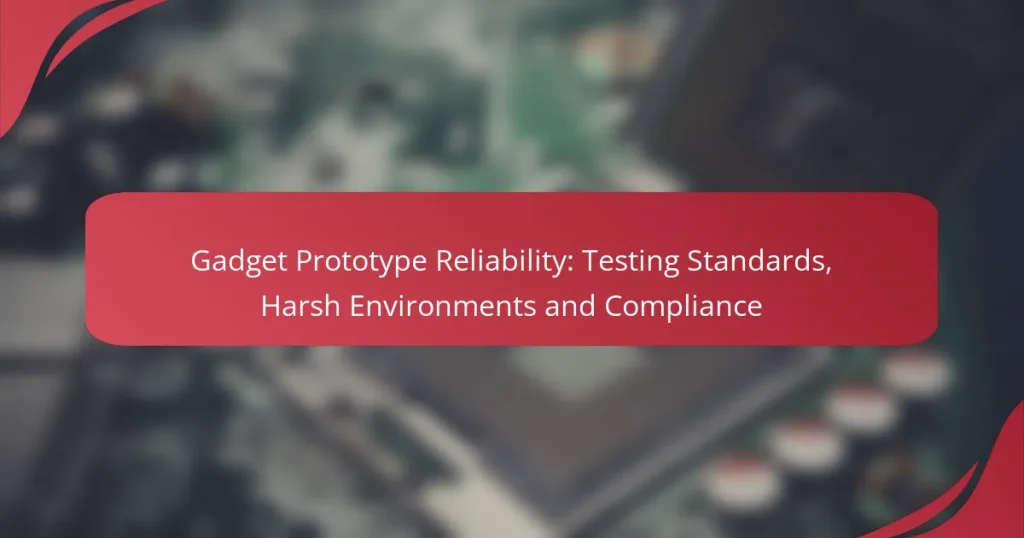Ensuring the reliability of gadget prototypes is crucial for their success in the market, requiring a blend of rigorous testing, environmental evaluations, and user feedback. Adhering to established testing standards not only guarantees compliance with industry regulations but also helps identify potential issues early, thereby enhancing product quality. Additionally, prototypes must be assessed for performance in harsh environments, as extreme conditions can adversely affect their functionality and longevity.

How to ensure gadget prototype reliability?
Ensuring gadget prototype reliability involves a combination of thorough testing, environmental assessments, and user insights. By following structured protocols and incorporating feedback, developers can create durable and effective prototypes that meet user needs.
Conduct rigorous testing protocols
Implementing rigorous testing protocols is essential for validating the reliability of gadget prototypes. This includes stress testing, performance evaluations, and compliance checks against industry standards such as ISO or IEC. Testing should cover various scenarios to identify potential failures before the product reaches the market.
Common testing methods include functional testing, where each feature is evaluated, and endurance testing, which assesses how long the gadget can operate under extreme conditions. Regularly updating these protocols based on previous findings can enhance reliability over time.
Utilize environmental simulation chambers
Environmental simulation chambers are crucial for testing prototypes under extreme conditions such as temperature fluctuations, humidity, and pressure changes. These chambers allow developers to replicate real-world scenarios that the gadget may encounter, ensuring it performs reliably in diverse environments.
For example, a gadget intended for outdoor use should be tested for resistance to moisture and temperature extremes. By simulating these conditions, developers can identify weaknesses and make necessary adjustments before launch.
Implement user feedback loops
User feedback loops are vital for understanding how prototypes perform in real-world situations. Gathering insights from early users can highlight usability issues and areas for improvement that may not be evident during initial testing phases.
To establish effective feedback loops, consider using surveys, interviews, or usability testing sessions. Analyzing this feedback can guide design modifications and enhance overall reliability, ensuring the final product aligns with user expectations.
Adopt iterative design processes
Adopting iterative design processes allows for continuous improvement of gadget prototypes. This approach involves developing prototypes in cycles, where each iteration incorporates feedback and testing results to refine the product progressively.
For instance, after each prototype version is tested, developers can make adjustments based on performance data and user feedback. This method not only enhances reliability but also fosters innovation by encouraging experimentation and adaptation.
Incorporate quality assurance measures
Incorporating quality assurance measures throughout the development process is essential for ensuring gadget prototype reliability. This includes establishing clear quality standards, conducting regular inspections, and implementing testing at various stages of production.
Quality assurance can involve automated testing tools to streamline processes and reduce human error. By prioritizing quality at every stage, from design to production, developers can significantly reduce the likelihood of failures and improve user satisfaction with the final product.

What testing standards are essential for prototypes?
Essential testing standards for prototypes ensure reliability, safety, and compliance with industry regulations. These standards help identify potential issues early in the development process, minimizing risks and enhancing product quality.
ISO 9001 for quality management
ISO 9001 is a globally recognized standard for quality management systems (QMS). It focuses on consistent quality in products and services, emphasizing customer satisfaction and continuous improvement.
Implementing ISO 9001 involves establishing a QMS that documents processes, defines roles, and sets measurable objectives. Regular audits and reviews help maintain compliance and drive improvements.
For prototypes, adhering to ISO 9001 can streamline development, reduce waste, and enhance overall product reliability, making it a vital standard for manufacturers.
IEC 61000 for electromagnetic compatibility
IEC 61000 outlines standards for electromagnetic compatibility (EMC), ensuring that electronic devices function correctly in their intended environments without causing interference. This is crucial for prototypes that will operate alongside other electronic equipment.
Testing under IEC 61000 involves assessing both emissions (how much electromagnetic interference a device produces) and immunity (how well it can withstand interference from other devices). Compliance helps prevent failures in real-world applications.
Prototypes should undergo EMC testing early in development to identify potential issues, as resolving these problems later can be costly and time-consuming.
ASTM standards for material testing
ASTM standards provide guidelines for testing the physical and mechanical properties of materials used in prototypes. These standards help ensure that materials meet specific performance criteria under various conditions.
Common ASTM tests include tensile strength, impact resistance, and fatigue testing. Selecting the right ASTM standards depends on the materials used and the intended application of the prototype.
Incorporating ASTM standards into the testing phase can help identify material weaknesses early, allowing for adjustments that enhance durability and performance in harsh environments.

How do harsh environments affect gadget prototypes?
Harsh environments can significantly impact the reliability and functionality of gadget prototypes. Factors such as extreme temperatures, high humidity, and the presence of dust can lead to performance degradation, component failure, and reduced lifespan.
Impact of temperature extremes on performance
Temperature extremes can cause electronic components to operate outside their optimal range, leading to malfunctions. For instance, high temperatures may result in overheating, while low temperatures can lead to brittleness in materials. It’s crucial to test prototypes in temperature ranges that reflect their intended use, typically from -20°C to 60°C for consumer electronics.
To mitigate risks, consider using temperature-resistant materials and implementing thermal management solutions. Regularly monitor temperature during testing to identify potential failures early.
Effects of humidity on electronic components
High humidity can lead to corrosion of electronic circuits and connectors, which may compromise functionality. Moisture can also cause short circuits and affect the insulation properties of materials. Testing in environments with humidity levels exceeding 85% is essential for devices intended for tropical climates.
To protect against humidity, use conformal coatings and ensure proper sealing of components. Regular inspections and maintenance can help identify moisture-related issues before they escalate.
Challenges posed by dust and debris
Dust and debris can obstruct moving parts and interfere with electronic connections, leading to performance issues. Prototypes designed for outdoor use must be tested in dusty environments to ensure they can withstand particulate exposure. Devices may need to meet IP (Ingress Protection) ratings to confirm their resistance to dust.
Implementing filters and protective casings can help reduce the impact of dust. Regular cleaning and maintenance schedules are also advisable to keep devices functioning optimally in challenging environments.

What compliance regulations must prototypes meet?
Prototypes must adhere to various compliance regulations to ensure safety, performance, and marketability. Key regulations include FCC for electronic devices, CE marking for access to the European market, and RoHS for limiting hazardous substances.
FCC regulations for electronic devices
The Federal Communications Commission (FCC) regulates electronic devices in the United States to prevent interference with communication networks. Prototypes must undergo testing to demonstrate compliance with FCC standards, which often involves measuring electromagnetic emissions.
To meet FCC requirements, manufacturers should prepare for pre-compliance testing early in the design phase. This can help identify potential issues and reduce costly redesigns later. It is advisable to work with accredited testing labs to ensure accurate results and proper documentation.
CE marking for European market access
CE marking signifies that a product meets European Union safety, health, and environmental protection standards. For prototypes, obtaining CE marking involves a conformity assessment process that may include testing, technical documentation, and a declaration of conformity.
To achieve CE marking, manufacturers should familiarize themselves with relevant directives, such as the Low Voltage Directive or the Electromagnetic Compatibility Directive. Engaging with notified bodies can provide guidance and streamline the certification process, ensuring compliance before market entry.
RoHS compliance for hazardous substances
The Restriction of Hazardous Substances (RoHS) directive restricts the use of specific hazardous materials in electrical and electronic equipment. Prototypes must be tested to ensure they do not exceed limits for substances like lead, mercury, and cadmium.
Manufacturers should implement a materials management system to track and verify the compliance of components. Regular audits and supplier assessments can help maintain RoHS compliance and avoid penalties, ensuring that products are safe for consumers and the environment.

What are the best practices for testing in extreme conditions?
Testing in extreme conditions involves simulating harsh environments to ensure gadget prototypes can withstand real-world challenges. Best practices include using specialized testing methods, conducting field tests, and implementing rigorous stress testing protocols.
Use accelerated life testing methods
Accelerated life testing (ALT) aims to identify potential failures by subjecting prototypes to heightened stress levels, such as temperature extremes or increased humidity. This method helps predict product lifespan and reliability under normal operating conditions.
Common techniques include thermal cycling, vibration tests, and humidity exposure. These tests can reveal weaknesses in materials or design, allowing for timely adjustments before full-scale production.
Conduct field tests in real-world scenarios
Field testing involves deploying prototypes in actual environments where they will be used, providing invaluable insights into performance and durability. This practice helps identify unforeseen issues that laboratory tests may not capture.
Consider testing in diverse conditions, such as extreme temperatures, varying altitudes, or high humidity. Collecting user feedback during these tests can also guide improvements and enhance user experience.
Implement stress testing protocols
Stress testing evaluates how prototypes perform under extreme loads or conditions beyond normal use. This can include electrical overloads, mechanical stress, or environmental extremes like dust or moisture.
Establish clear protocols that outline the parameters for stress tests, including duration and intensity. Regularly review results to identify patterns of failure, which can inform design changes and improve overall reliability.

How to select the right testing equipment?
Selecting the right testing equipment is crucial for ensuring the reliability of gadget prototypes in various environments. Consider factors such as the specific tests required, the environmental conditions, and compliance with relevant standards.
Understanding testing standards
Testing standards define the protocols and criteria for evaluating the performance and safety of gadgets. Familiarize yourself with standards like ISO, IEC, and ASTM, which provide guidelines for various testing scenarios, including environmental stress tests and safety evaluations.
When selecting equipment, ensure it meets these standards to avoid compliance issues. For instance, equipment used for temperature testing should adhere to the relevant temperature ranges specified in the applicable standards.
Evaluating harsh environments
Gadgets often face harsh environments, such as extreme temperatures, humidity, or mechanical stress. Choose testing equipment that simulates these conditions accurately. For example, thermal chambers can replicate high and low temperatures, while vibration tables can test mechanical durability.
Consider the specific conditions your prototype will encounter. If it’s intended for outdoor use, ensure the equipment can test for factors like UV exposure and moisture resistance.
Ensuring compliance
Compliance with industry regulations is essential for market acceptance. Identify the relevant regulations for your gadget, such as FCC for electronic devices in the U.S. or CE marking in Europe. Select testing equipment that can validate compliance with these regulations.
Regularly review updates to compliance requirements, as they can change. Using accredited labs and certified equipment can help streamline the compliance process and ensure your prototype meets necessary standards.


